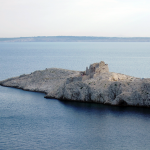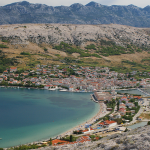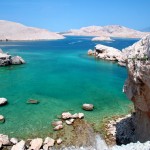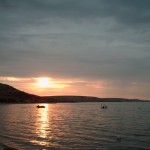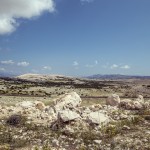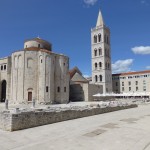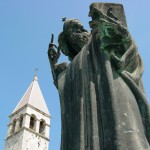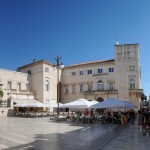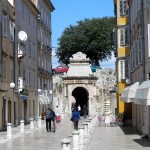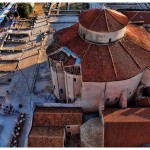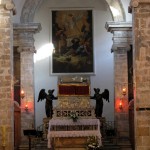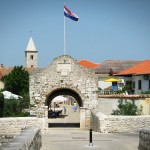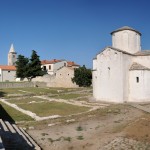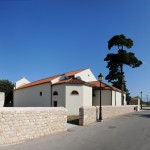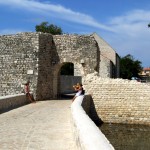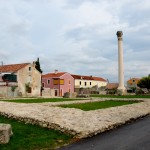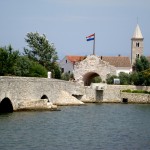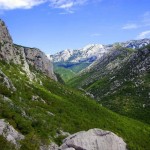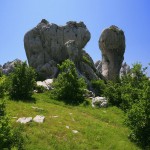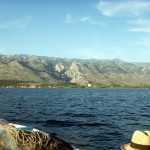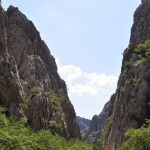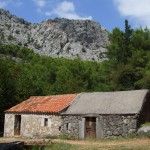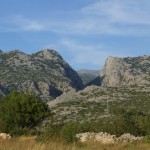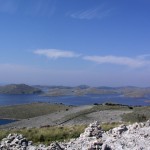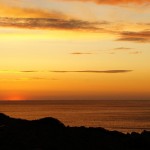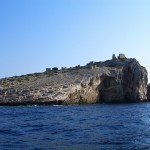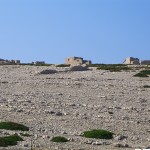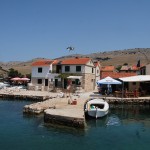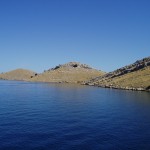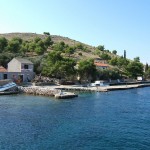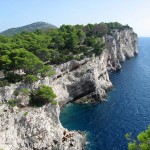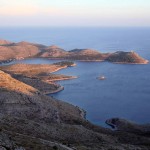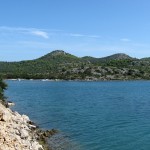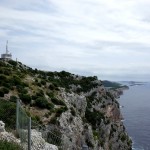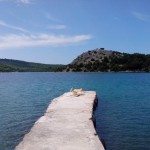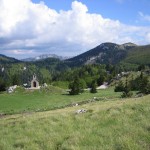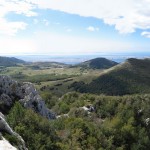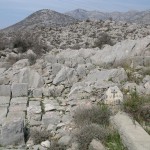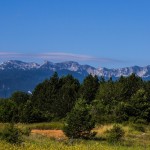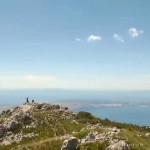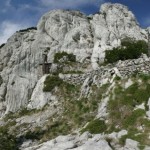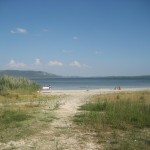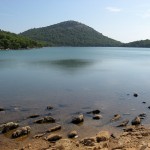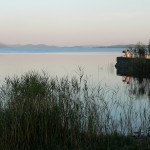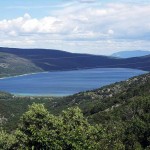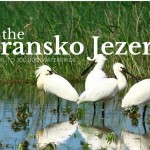For all those that enjoy sailing, the island of Pag represents a particularly attractive locality, being elongated and irregularly shaped, the island that is 50 km long from its Western Cape Lun to the most remote eastern point of Fortica. The largest portion of its surface is covered in ungenerous rocky grazing land for sheep from whose milk the famous cheese is manufactured. The nature is expressed in its fullest in Pag cheese – in its intense salty flavour you can clearly taste the salt that is raised from the surface of the sea by the Bora, spreading it over the entire area under the Velebit, as well as throughout the Pag’s rocky grounds. It is as if this dark grey armour of the island and its complex structure gained their natural counterpart in the Pag lace. However, while the ruffled Mediterranean nature has created order hidden in chaos on the surface of Pag, Pag lace is all about order and geometric ornaments which strongly state the desire to create a well adapted environment in an ambiance that is not overly friendly for men. Today’s city of Pag developed in the fifteenth century, and precisely from such a desire to implement order, in accordance with the urban and architectural plan of the architect and sculptor Juraj Dalmatinac (Juraj the Dalmatian), who conveyed his memories of antique city plans of most of Adriatic cities into the creation of the new Pag.
The City of Zadar
The Church of St. Donat from the 9th century – unique in Europe, The Forum from the 1st century, from the era of emperor August – the largest explored forum on the eastern coast of Adriatic, The Convent of St. Fran with the treasury and the oldest Gothic church in Dalmatia
The St. Stošija Cathedral from the 13th century is one of the most beautiful examples of the Romanesque Period in Croatia, with the floor mosaic from the 5th century;, The Church of St. Krševan from the 12th century is one of the most beautiful examples of the Romanesque Period in Croatia; The Bell Tower of the Church of St. Mary (Marije) from 1105, a beautiful example of the Romanesque Period, it was built by a Croatian-Hungarian king Koloman; A small church of St. Peter and Andrew Senior (Petra i Andrije Starog) from the 5th – 6th century;
A Chest of St. Simon (Šime) containing the body of the saint is the most valuable example of the goldsmith craft from the Middle Ages in Croatia; The fortress walls with representative Renaissance Land gates from the 16th century; – Sea Gates with a built-in Roman triumphal arch; Permanent exhibition of ecclesiastic art in which there are many gilt ecclesiastic objects in the shape of reliquaries, as well as pictures from Zadar churches and churches in the surrounding area.
The City of Nin
A small church of St. Cross (Križa) from the 9th century, also known as “the smallest cathedral in the world”; A small church of St. Nicholas (Nikole) from the 11th century on the hillock between Nin and the Tourist Settlement of Zaton, The August Temple from the 1st century – its ground plan makes it the largest temple in the Dalmatian area; The archaeological collection with one restored Liburnija ship – serilia liburnica, Restored old Croatian ships “Condure Croatice”; The Cathedral treasury; The Church of St. Asel 6th -18th century; The Church of St. Ambrose (Ambroza) from the 13th century; Lower and Upper gates (Donja i Gornja vrata) of the city; Lower and Upper City Bridge (Donji i Gornji most) from the 16th century; The remains of the wall from the Venetian period; Bronze statue of Grgur Ninski;
Grbe: gates of the oldest tobacco factory in the Adriatic – 18th century;
Vrsi: a small church of St. Jacob (Jakov) – 15th century
Natural landmarks
Paklenica
The area between the highest point of Velebit (Vaganski vrh (point) – 1757 m) and the sea has been declared a National Park in 1949, the park that differs from the others mainly due to unique canyons of Velika and Mala Paklenica, which, on their way seaward, create an endless number of minute waterfalls, with cliffs as high as 400 m – of which the most renowned is Anića kuk (Anića hip). Paklenica is a true challenge for mountaineers, alpinists and scientists, as well as a favourite destination for nature enthusiasts and excursionists. Opulent and diverse benthos (many endemic species, the only habitat of the griffon vulture in the continental part of Croatia, etc.), numerous karstic phenomena, amongst which stands out the Cave Manita peć (Crazy oven) and miscellaneous offer of sporting activities (alpinism, free-climbing, hiking, trekking, bird-watching, etc.) attract more and more visitors. It is particularly necessary to emphasize the vicinity of the sea, enabling the guests of the National park to swim, as well enjoy mountaineering activities in the same day.
Kornati
The National Park of Kornati is one of the most developed island groups in the Mediterranean, a unique entanglement of 150 islands, small isles and cliffs, strewn in the central part of the Adriatic. This is the part of Adriatic in which the azure colour of the Kornati Sea is even more distinct in the contrast to the white and grey rocky ground that dominates the islands. With their unique clear sea, abundance of sun, numerous coves, bays and small ports, Kornati represent an unavoidable destination for navigators while wandering along the Adriatic, as well as a perfect choice for today’s Robinson Crusoe’s.
Telašćica
Telaščica is one of the largest, safest and certainly most beautiful Croatian natural harbours, a favourite destination of navigators while wandering from the north to the south of the Adriatic or vice versa.. This is a natural extension of the Kornati National Park, although somewhat greener and more wooded than the islands within the National park. The bay is situated on the southern side of Dugi otok (Long Island), being 8200 m long, having 25 coves, 5 small isles, a particularly developed coast that is 68 km long, and a magnificent entrances into the bay surrounded by 14 larger and smaller islands. The cove alone can not be seen from either side since it is sheltered by high and steep cliffs of Dugi otok from the open sea on one side and the islands on the other side, and as we sale more into the interior of the cove we are able to enjoy all the more beautiful scenery and the view to the developed coast overfilled with smaller coves and isles, some of its parts looking like small lakes. A special natural phenomenon is also situated in Telaščica – a salty lake of Mir (Peace) to which leads a footpath and that is usually warmer than the sea. From the lake leads a pathway to a place from which extends an unforgettable view onto the Adriatic open sea and the south-west part of Kornati. Specifically, here are situated the highest cliffs on the Adriatic (Grpašćak – 166 m) that protect the bay from the fury of the open sea. All around the bay there are tame karst fields with opulent Mediterranean vegetation, with 300 kinds of plants. One can also find mouflons here, while the sea is a home for around 250 plant and animal species. The remains of ville rusticae in Mala Proversa gorge bear witness to the fact that this area, even during the Roman times, was a vacationing destination.
Velebit
The Mountain of Velebit is the most powerful representative of the Dinaric Mountains that naturally separate the Mediterranean from the continental part of Croatia. It is 145 kilometres long, and due to the diversity of plants and wildlife, as well as the unusual relief, Velebit received an international recognition in 1978 – a UNESCO Charter by which it was included into the group of international biosphere reserves within the scientific program under the title “Man and Biosphere”. Today there are two national parks in the area of Velebit, being declared a nature park in 1981 – those national parks being Paklenica and North Velebit.
Vransko Lake
The Mountain of Velebit is the most powerful representative of the Dinaric Mountains that naturally separate the Mediterranean from the continental part of Croatia. It is 145 kilometres long, and due to the diversity of plants and wildlife, as well as the unusual relief, Velebit received an international recognition in 1978 – a UNESCO Charter by which it was included into the group of international biosphere reserves within the scientific program under the title “Man and Biosphere”. Today there are two national parks in the area of Velebit, being declared a nature park in 1981 – those national parks being Paklenica and North Velebit.


